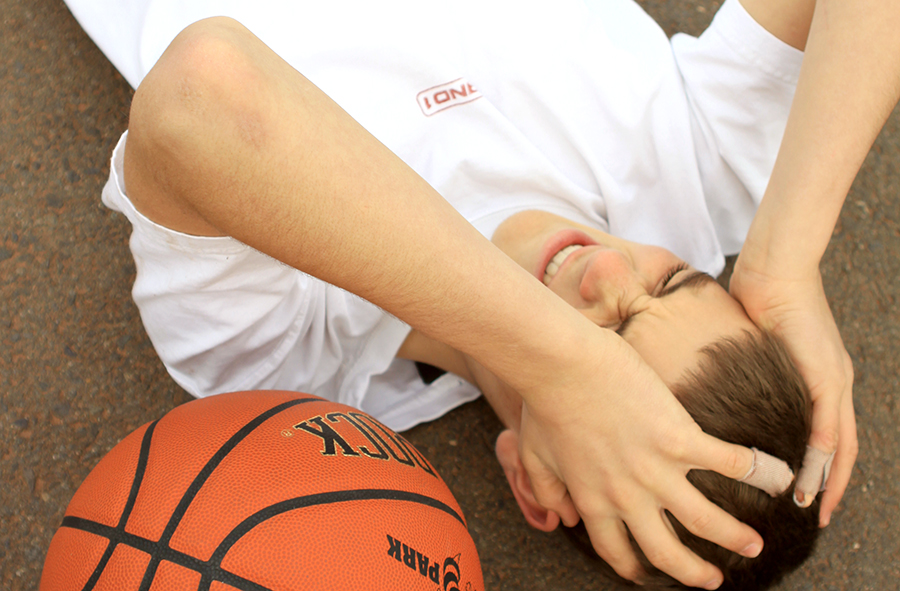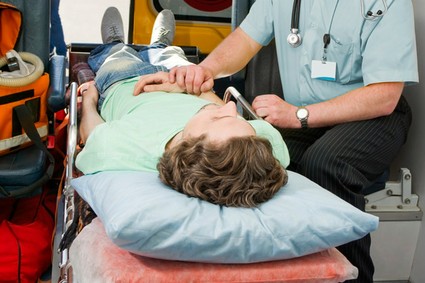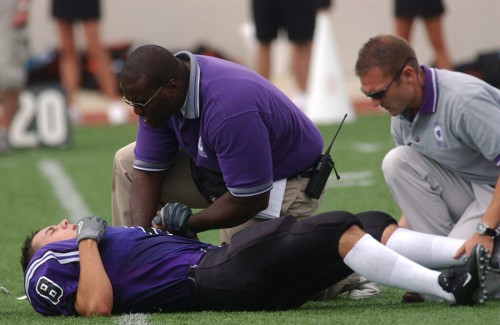Reading Test May Diagnose Sports Concussions
Ok, it’s pretty much the last drive down the field for the high school home team who needs a touchdown to win and they are within 15 yards of the goal. On the first snap someone comes from nowhere and sideswipes the quarterback – now he’s lying limp on the field without the slightest movement.
High school football player knocked out during gameBy the time the coach runs on the field the player is moving and demanding that people “quit making a fuss” over him so he can get on with the game. There’s a touchdown to be scored!
That’s when YOU arrive to their side (didn’t I tell you that YOU were the team physician?) Good ‘ol doc [your name here] , you’ll soon sort it out.
The coach, as eager as his QB to get the game finished, mistakes your slight pause while you assess the situation for hesitancy and thinks he’ll move you along by asking: “what happened? Were you knocked out?”
The blond-haired, blue-eyed, baby-faced boy, with one small blemish on his chin, first looked at you through his helmet’s face-protector so intensely that you could almost see his brain working to formulate an answer that wouldn’t get him taken out of the game and then turned to look innocently at the coach.
“No coach,” he said – the little fibber!
You move around in front of him and prepare to give him the old “stink-eye” for lying to the coach; but, realizing he’s been “made” the still supine form decides to rotate his head and avert his gaze. (At least you know it’s not his neck that’s hurt)
The poor, adrenaline-buzzed, ethically-challenged, misguided twit isn’t even considering that he probably just had a concussion AND that if he suffers another head hit on the next play, or even within the next hours’ or days’ “window” until he heals from the first one, he is gynormously likely to suffer more severe nerve/brain damage and even death!
Pediatric Sports Concussions
Concussion Diagnosis Difficult
You think this is just a make-believe story? Well, the part about you being a doctor might be, but this identical script is acted out thousands of times each year on middle, junior and high school football fields all over the U.S., Canada, South America and all points east or west of here. Not to mention college level; which unfortunately, from the level that I’m sitting at these days, are still just “kids.”
The many articles before this should have convinced you that professional contact sports are being shown to be vastly more dangerous to players’ nervous systems than we’ve ever thought possible – and children’s contact sports even more so.
 Baseball pitcher prone on mound after a concussionSo, as team doc’ what are you going to do? Come on, Everyone’s waiting.
Baseball pitcher prone on mound after a concussionSo, as team doc’ what are you going to do? Come on, Everyone’s waiting.
Not so easy is it? And, believe me, the LEAST of your worries is the fact that hundreds of eyes are on you and look ready to fly out of those stands and flatten you into oblivion (mostly fathers) if you even look like you’re going to take the boy to the side-lines. Nor is it the hundreds (mostly mothers and opposing team) who have the same intent if you DON’T get the boy out to “safety.”
The REAL problem is that, as everybody seems to be finding out, our standard “tests” for concussion have been based on balance symptoms and cognition tasks; and, frankly, they really have come into question of late because they aren’t all that good in picking up subtle concussion injuries.
Eye Tracking Test and Concussion
That’s what I’m writing about today. Some great experience with a large group of athletes and a different testing technique has just been reported about at the American Academy of Neurology (AAN) 66th Annual Meeting (Apr, 2014). It’s a simple vision test known as the King-Devick which seems to be non-subjective, resistant to lying and much more sensitive to subtle indicators of concussion.
This new use for an absurdly simple eye-tracking test which has been around for awhile sometimes even picks up a concussion when the player doesn’t realize he’s been concussed. And the interesting thing is that using it WITH existing tests like the Standardized Assessment of Concussion (SAC) and Balance Error Scoring System (BESS) seems to even add to the accuracy.
How does it work? Well, because the visual pathways are commonly affected in concussion, that is what is tested. And you may not believe me because it seems so simple.
At the start of the season the player is given a series of numbers to read from index cards or an iPad screen as rapidly as they can. Saying the single digit numbers aloud requires the eyes to track left to right in randomly spaced jumps then jump to a next line.
The shortest of two attempts becomes his or her individualized baseline value. Then, after an injury the same set of tests are conducted — even right at the game. If the time taken is longer than at baseline, then concussion is diagnosed.
 Boy with head trauma during a basketball practiceYes, it’s proven to be reliable; and, no, it’s not the excitement of the game that slows down the visual processing rate. The authors of the research say: “After exercise, scores will usually be the same as or faster than baseline. Any slowing in the time taken to complete the tests was the definition of concussion used in this study.”
Boy with head trauma during a basketball practiceYes, it’s proven to be reliable; and, no, it’s not the excitement of the game that slows down the visual processing rate. The authors of the research say: “After exercise, scores will usually be the same as or faster than baseline. Any slowing in the time taken to complete the tests was the definition of concussion used in this study.”
Concussion Research Study
How can the researchers make such a statement? From real-life experience! Two hundred and seventeen athletes, aged 18 to 22 years, playing on the University of Florida men’s football, women’s soccer, and women’s lacrosse teams participated in the study which was supported by the National Institutes of Health (NIH).
All of the tests I mentioned were given at the beginning and end of their respective seasons. In addition, the entire battery was given after any head injury and repeated every day until back to baseline.
There were 30 athletes who had their first concussion during the season and 79% of them showed worsening time-scores on the eye-tracking (King-Devick) test [any time which was more than baseline raises concern.]
The SAC test, which has been commonly used, only picked up 52% and the BESS test 70% – but, surprisingly, not the same players. Combining eye-tracking and SAC captured 89% of concussions and of course using all 3 tests identified the 100% in the sample.
But wait, there’s more!
At the same conference a second study was presented which involved 141 high school hockey players and compared the eye-tracking test with an existing computerized cognitive assessment test from Axon Sports which was given before and after the season.
Twenty of those players reported head injury of varying degree during the season and ALL twenty had immediate post-concussion eye-tracking times greater than 5 seconds from baseline (avg 7.3 seconds) and 18 of those still had delays persisting at the post-season test.
But wait, there’s more!
At the post season testing, there were 11 players who neither reported nor were observed to have a significant head impact; but who, none-the-less, had worse eye-tracking times. Which makes one wonder if a concussion had been “missed.”
Remove From Field for Testing
There you go. An additional observation to use in these all-too-often occurrences where the risk of a concussion in a child is being considered. The presenters of the study at the conference summarized that: “athletes should undergo pre- and post-season K-D testing, with additional evaluation real-time to inform the assessment of suspected concussion.”
Back to your personal dilemma at the game, once it’s felt that the boy was safe to be moved from the field to the side-lines, that’s where you take him for a more specific look – as you should do, either by substitution or time-out.
You should be running the SAC and probably the BESS and now it looks like the eye-tracking testing might also be a benefit – IF, you’ve thought ahead enough to obtain a baseline time for the player.
Concussion Resources
- Acute Concussion Evaluation – ACE form – physician/office version
- Standardized Assessment of Concussion – SAC form
- Standardized Assessment of Concussion – SAC-form B
- Sport Concussion Assessment Tool 2 – SCAT2 form
- Balance Error Scoring System test – BESS Protocol
- Balance Error Scoring System test – BESS Demo
- King-Devick test – KD Scoresheet
- King-Devick test – KD Demo
- Ten things you don’t know about concussion – Concusions
- Return to play after concussion, Mayo Clinic – Return to play
- Standardized Mental Status Testing on the Sideline After Sport-Related Concussion – NIH Article
All of these take time! In the scenario given, the fibbing boy cannot possibly return to play in the amount of time left in the game; which brings up one of the many controversies in this subject: just how much “diagnosing” should go on at the sidelines during the game, and just how much “expertise” can/should athletes, parents and spectators expect out of those on the sidelines?
Controversies and Decisions
 There are those (a substantial number) who believe that none of these tests have been adequately validated as diagnostic tools to the level necessary for use in the medical treatment of children.
There are those (a substantial number) who believe that none of these tests have been adequately validated as diagnostic tools to the level necessary for use in the medical treatment of children.
Many physicians hold the opinion that: “if sideline personnel suspect that an athlete has sustained a concussion, they should send him or her to see a concussion specialist. Period!” They don’t believe that performing a SCAT2, BESS, SAC or KD is needed to document that suspicion.
The “safe” way (in an ideal world) would be that IF anyone “thinks” there has been enough impact to concuss a child THEN the child should be removed from the press of the crowd and game to be evaluated medically by a trained physician.
Even the legal disclaimer on the SCAT test form demands that: “in the event an athlete, after a direct or indirect blow to the head, displays any obvious potential signs of concussion (LOC, balance or motor in-coordination, disorientation or confusion, loss of memory, blank vacant look, visible facial injury in combination with any of the other signs), the athlete should stop participation, be evaluated by a medical professional and should not be permitted to return to sport the same day.”
This article has never been about professional sports – they do whatever they want for whatever reason they come up with as “consenting adults” – we’ve ONLY ever been talking about children playing a GAME! And the perspective must be that “games” are ALWAYS inferior to health, life and education… always.
In children’s sports the KD, BESS, ACE SCAT and any other procedure we come up with can be wonderful adjuvants to our decision making and, I suppose could take some of the unrealistic “heat” away from those souls in the trenches trying to keep the “games” safe and sane.
[American Academy of Neurology (AAN) 66th Annual Meeting. Abstracts S19.006, S11.0031977.]
11 Posts in Childhood Concussion (concussion) Series
- Helmits?! Do they prevent concussions? – 5 Apr 2017
- Video- concussion management – 30 May 2016
- Video: Concussion 101 – 6 May 2016
- TBI, concussion and early nutrition – 28 Apr 2016
- 5 things to know – 12 Sep 2015
- Football and brain damage – 21 Aug 2015
- 10 scary issues – 18 Jun 2015
- Reading test a predictor of concussion – 30 May 2014
- New guidelines for sports – 27 Jul 2013
- More dangerous than we thought – 24 Jul 2013
- Childhood Concussion Series: Intro/Index – 23 Jul 2013

